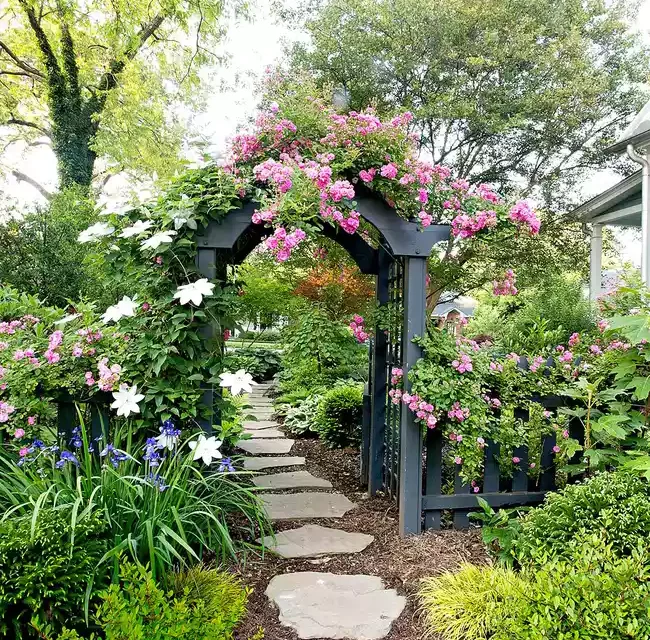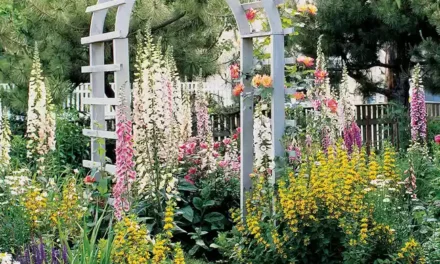Starting a garden is one of the most rewarding things you can do. Plant fragrant florals or start a vegetable garden (or both!), and everyone can benefit from getting their hands a little dirty. But if you’re new to gardening, it can be difficult to know where to start. Still, it doesn’t have to be complicated; when you break your project down into manageable steps, you can ease into gardening at your own pace. And soon you’ll see the rewards of your efforts with beautiful views, delicious flavors, and colorful blooms. These steps given by Pritish Halder will help you get started from scratch, but if you have something particular in mind, you could also use a garden plan to guide your design.
:max_bytes(150000):strip_icc():format(webp)/stone-walkway-leading-garden-ccab4820-64cc37892feb45a58001bc53f6ba7aeb.jpg)
-
Consider What to Plant
Do you want to plant a vegetable garden? An herb garden? A flower garden? If you choose vegetables and herbs for their contributions to your dinner table, plant ones your family will eat or be willing to try. If you want flowers for their flair, color, and fragrance, decide whether you want annuals that bloom most of the summer but need to be replanted each spring or perennials that have a shorter bloom time but return year after year. Each one, or even a combination, makes a stunning garden but will have different maintenance requirements. One bit of advice: Start small until you know what you’re getting into.
-
Pick the Best Garden Spot
Almost all vegetables and many types of flowering plants need 6-8 hours of full sun each day. So, you need to observe your yard throughout the day to figure out which spots receive full sun versus partial or full shade. Don’t worry if your yard is mostly shady: You won’t be able to grow tomatoes in shade, but many other plants (such as host as and outdoor ferns) will do just fine. Check plant tags or ask the staff at your local garden centre to help you understand out how much sun a plant need.
:max_bytes(150000):strip_icc():format(webp)/person-raking-soil-89bf9d8a-febbfed23dec4038afc89777723f9404.jpg)
-
Clear the Ground
Get rid of weeds and sod in the area you plan to plant. If you want quick results—for example, if it’s already spring and you want veggies this summer—cut it out. Slice under the sod with a spade. Cut the sod into sections to make it easier to remove, then put it on your compost pile to decompose.
For a longer-term project, it’s easier to use the lasagna gardening method: Cover your future garden with five sheets of newspaper; double that amount if your lawn is Bermuda grass or St. Augustine grass. Spread a 3-inch layer of compost (or combination of potting soil and topsoil) on the newspaper and wait. It’ll take about four months for the compost and paper to decompose. But if you start in the fall, by spring you’ll have a bed ready to plant with no grass or weeds and plenty of rich soil.
-
Test and Improve Your Soil
To learn more about your soil, have a soil test done through your county cooperative extension office. They’ll lead you through the procedure: How much soil to send from which parts of the garden and the best time to obtain samples. Expect a two-week wait for the findings, which will tell you what your soil lacks and how to amend it. You can also use a DIY kit that may not be as detailed, but will give you an idea of your soil’s nutrient levels.
-
Prepare Your Planting Beds
Loosening the soil in new beds before sowing or planting helps roots to grow more easily and access the water and nutrients they need. There are two methods: tilling with a mechanical device such as a rototiller or digging by hand. The first one is a good method when you need to mix in large amounts of amendments. However, it’s easy to overdo it, which will end up damaging soil structure. Digging is more practical for preparing small beds.
:max_bytes(150000):strip_icc():format(webp)/person-pouring-seeds-soil-e5ded2ee-f8ac03d520f441ea9ccc54356abc352e.jpg)
-
Pick Your Plants
Some people pore over catalogues for months; others head to the garden centre and buy what wows them. Either method works as long as you choose plants adapted to your climate, soil, and sunlight. You can even surf the Internet for plants to purchase. Here are a few easy-to-grow plants for beginners:
- Annuals: Calendula, cosmos, geraniums, impatiens, marigolds, sunflowers, and zinnias
- Perennials: Black-eyed Susan, daylilies, lamb’s ears, pansies, phlox, purple coneflowers, and Russian sage
- Vegetables: Cucumbers, lettuce, peppers, and tomatoes
-
Start Planting
Some plants, such as pansies and kale, tolerate cold, so you can plant them in autumn or late winter. Tomatoes and most annual flowers, on the other hand, prefer warm temperatures, so don’t plant them until the danger of frost has passed in your area. Midspring and mid -autumn are good times to plant perennials.
:max_bytes(150000):strip_icc():format(webp)/person-watering-garden-02cb5f86-296b3ed4b37d4a0a9a4f203a1c8cd7ed.jpg)
-
Water at the Right Time
Seedlings should never be allowed to dry out, so water daily. Taper off as the plants get larger. Transplants also need frequent watering (every other day or so) until their roots become established. After that, how often you need to water depends on your soil, humidity, and rainfall, though once a week is a good place to start. Clay soil dries out more slowly than sandy soil, so you won’t need to water it as often.
-
Protect Your Garden with Mulch
To help keep weeds out and moisture in, cover the soil with a couple of inches of mulch. You won’t have to water as often, and by preventing sunlight from hitting the soil, you’ll prevent weed seeds from germinating. Choose from a wide variety of mulches, each with its own benefits, including shredded bark, straw, and river rock.
:max_bytes(150000):strip_icc():format(webp)/removing-weed-roots-hand-spade-dac218f0-81aa5ebb6050475ab988c041a067c401.jpg)
-
Maintain Your Garden Regularly
As your garden begins to grow, help it reach its full potential by keeping up with garden chores. Water the plants before they wilt. Pull weeds before they go to seed. Get rid of dead, dying, and diseased vegetation. Banish destructive insects (such as tomato hornworms) by picking them off the plant and dropping them into a bucket of sudsy water, hosing them off, or spraying on an insecticidal soap purchased at a garden centre. Support tall plants (such as tomatoes) with a trellis, stake, or a tepee. Also, harvest vegetables as soon as they’re ready. And remember to stop and smell the…well, whatever it is you’re growing.
Reference











